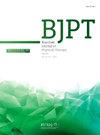Is self-reported symptom duration in individuals with patellofemoral pain an accurate measure? An observational longitudinal study
IF 3.1
3区 医学
Q1 ORTHOPEDICS
引用次数: 0
Abstract
Background
Although self-reported symptom duration of individuals with patellofemoral pain (PFP) is usually assessed for clinical and research purposes, its accuracy has never been investigated.
Objectives
We followed up individuals with PFP over 15 months to determine the agreement between self-reported symptom duration and calculated symptom duration.
Methods
Self-reported symptom duration of 39 participants was assessed at baseline and re-assessed at follow-up. Calculated follow-up symptom duration was determined by the summation of baseline self-reported symptom duration with the known follow-up duration. The symptom duration difference was determined by the subtraction of the calculated follow-up symptom duration and the self-reported follow-up symptom.
Results
We identified a symptom duration difference of 20.1 months (95 % confidence interval: 11.2, 29.1 months), with greater differences in individuals with longer symptom duration (r² = 0.12).
Conclusion
Our findings suggest that the accuracy of self-reported symptom duration measures in individuals with PFP is questionable and techniques should be used to improve it.
髌股疼痛患者自我报告的症状持续时间是否准确?一项观察性纵向研究。
背景:尽管自我报告的髌股疼痛(PFP)患者的症状持续时间通常用于临床和研究目的,但其准确性从未被调查过。目的:我们对PFP患者进行随访超过15个月,以确定自我报告的症状持续时间和计算的症状持续时间之间的一致性。方法:对39名受试者在基线时进行自我报告的症状持续时间评估,并在随访时重新评估。计算的随访症状持续时间由基线自我报告的症状持续时间与已知随访时间的总和确定。症状持续时间的差异由计算的随访症状持续时间与自我报告的随访症状相减确定。结果:我们发现症状持续时间差异为20.1个月(95%置信区间:11.2,29.1个月),症状持续时间越长个体差异越大(r²= 0.12)。结论:我们的研究结果表明,PFP患者自我报告的症状持续时间测量的准确性值得怀疑,应该使用技术来改善它。
本文章由计算机程序翻译,如有差异,请以英文原文为准。
求助全文
约1分钟内获得全文
求助全文
来源期刊
CiteScore
6.10
自引率
8.80%
发文量
53
审稿时长
74 days
期刊介绍:
The Brazilian Journal of Physical Therapy (BJPT) is the official publication of the Brazilian Society of Physical Therapy Research and Graduate Studies (ABRAPG-Ft). It publishes original research articles on topics related to the areas of physical therapy and rehabilitation sciences, including clinical, basic or applied studies on the assessment, prevention, and treatment of movement disorders.

 求助内容:
求助内容: 应助结果提醒方式:
应助结果提醒方式:


